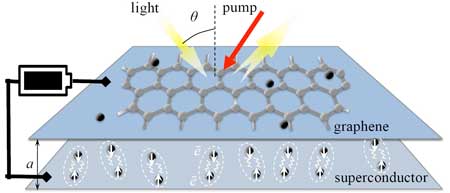Nanowerk February 3, 2020
An international team of researchers (South Korea, Russia, UK) propose a new type of optical transistor for broadband amplification of THz radiation. It is made of a graphene–superconductor hybrid, where electrons and Cooper pairs couple via Coulomb forces. The transistor operates via the propagation of surface plasmons in both layers, and the origin of amplification is the quantum capacitance of graphene. It leads to THz waves amplification, the negative power absorption, and as a result, the system yields positive gain, and the hybrid acts like an optical transistor, operating with the terahertz light. It can, in principle, amplify even a whole spectrum of chaotic signals that is required for numerous biological applications…read more. Open Access TECHNICAL ARTICLE

Light in the THz frequencies hits the ‘sandwich’ and is reflected with additional energy. (Image: Loughborough University)